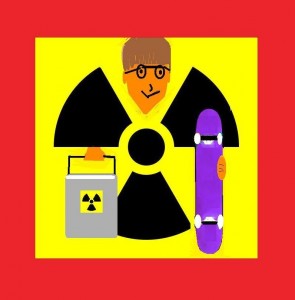Recruiting the Unrecruitable: Lessons from Taylor Wilson

MIXED SIGNALS/Image: Michael Moffa
Consider the following job candidate credentials : Previous employer—none. Degrees—none. Professional training—none. Years of professional employment—none. Availability—probably none. It’s not looking good.
But check out his references: Department of Homeland Security; U.S. Department of Energy; Department of Physics, University of Nevada; Intel International Science Fair; U.S. Patent Office. Now that’s looking better.
Ah, now the final snag: Age—17.
When Job Experience Doesn’t Count
But then there’s this one accomplishment: He is the youngest person in the world to have built an operational fusion reactor, which he cobbled together, working initially out of his basement and off the Internet, when he was 14. He’s also the first to create an inexpensive “active interrogation” Cherenkov nuclear-radiation detector that can scan incoming ship containers for dirty nuclear bombs—a project offered funding by the DHS, but declined because of pending patent issues. It’s also one of his three pet projects currently underway, the other two being a medical isotope and a neutron sourcing projects. Earlier, when he was 11, he took the important step of mining for uranium with his dad and buying vials of plutonium on the Internet.
Here’s his description of his radiation detection equipment: “…how it works is it fuses together heavy hydrogen – deuterium. And when these deuterium atoms fuse together, they give off neutrons. It’s that neutron radiation that goes into the cargo container, and depending on what the makeup of the cargo container is, it will react in such a way that it gives off radiation. I detect that radiation and it’s specific to whatever that cargo container’s contents are.”
Unless you have been living in a reactor core’s lead-lined deep-sixed containment vessel, you should immediately recognize this as an abbreviated resume for and summary by the heavily media-tracked Taylor Wilson, a Reno, Nevada high school teen prodigy who arguably and by comparison makes the teenage Mozart and Isaac Newton look like mere sandbox putterers and the rest of us, well, like something to be irradiated in a Petri dish, perhaps not more than an evolutionary rung or two above bread mold, in hopes of mutating us into something more advanced and productive.
When Inexperience Counts More
Inexplicably possessed by a fascination with nuclear energy when he was only ten, master Wilson embarked on a quest to build a fusion reactor, working with his own radioactive materials literally and figuratively dug up from sources both exotic and mundane and with equipment engineered with help from some very grownup grownups in the machining, nuclear physics and engineering fields. For the full details of his spellbinding, astonishing story, just Google him or start here, at his website.
If you were to interview him for a job, you might, for a nanosecond, but only a nanosecond, imagine he’s a normal teenager: “But the thing is, science is cool, and me and my friends who do science are cooler than the people who don’t,” he has been quoted as saying. However, everything he would say before and after that typical-teen blip would reveal his formidable and precocious intellectual poise and polish.
Cutting the aging legs out from under the “experienced only need apply” argument with commentary that could have been excerpted from a Hollywood boy-genius movie, Wilson says, “Because kids haven’t been exposed to the bureaucracy of professional science, they’re a lot more open to trying things.”
Rethinking Credential Requirements
Apart from the incredible synthesis of intellect, determination, technology and confidence required for Wilson to have pulled all of this off, one arresting aspect of his achievements is what it implies for recruiting.
A superficial glance at his “resume” suggested he would be totally unrecruitable and unsuitable. A second glance, and he is irresistible. Yet, his clout is evident only because of its dramatic physical, concrete engineered manifestations, e.g., his childhood fusion reactor and his current radiation detector. Now, imagine how many now older, gifted job applicants are passed over because their uncredentialed genius, which may have been manifested as early as Wilson’s, bore unpublicized fruit or results invisible to the eye, e.g., a talent for number crunching (like the mega-savant, Kim Peeks, a.k.a., “the Rain Man”, portrayed by Dustin Hoffman in the eponymous movie, and who had photographic recall of 12,000 books) or a gift for debugging software. For example, a former student of mine at a Toronto private school, then a gifted 16-year-old, has for decades been working as a successful IT consultant and designer, yet is only now finishing up his B.Sc. Would he have made it past your first cut without a degree?
The Futility of Trying to Recruit This Unrecruitable
Given the national security implications of Wilson’s work, it will come as no surprise if recruiters of all sorts are already chasing him. But then, given the same national security implications of his projects, it is also to be expected that most will have no chance—either in virtue of competition from national security or governmental nuclear energy entities, like the Lawrence Livermore National Laboratory or from their strict vetting of the civilian recruiter vetters.
True, should you try to recruit Wilson, you probably won’t suffer the fate of any class bully who might ever be foolhardy enough to threaten the “nerd” at lunchtime or try to steal his lunch money, only to be whisked away by suits in sunglasses and soon thereafter finding himself grooming camels hitched to some tent in Afghanistan. However, you can expect to have to take a number and join the queue.
A very long queue.

